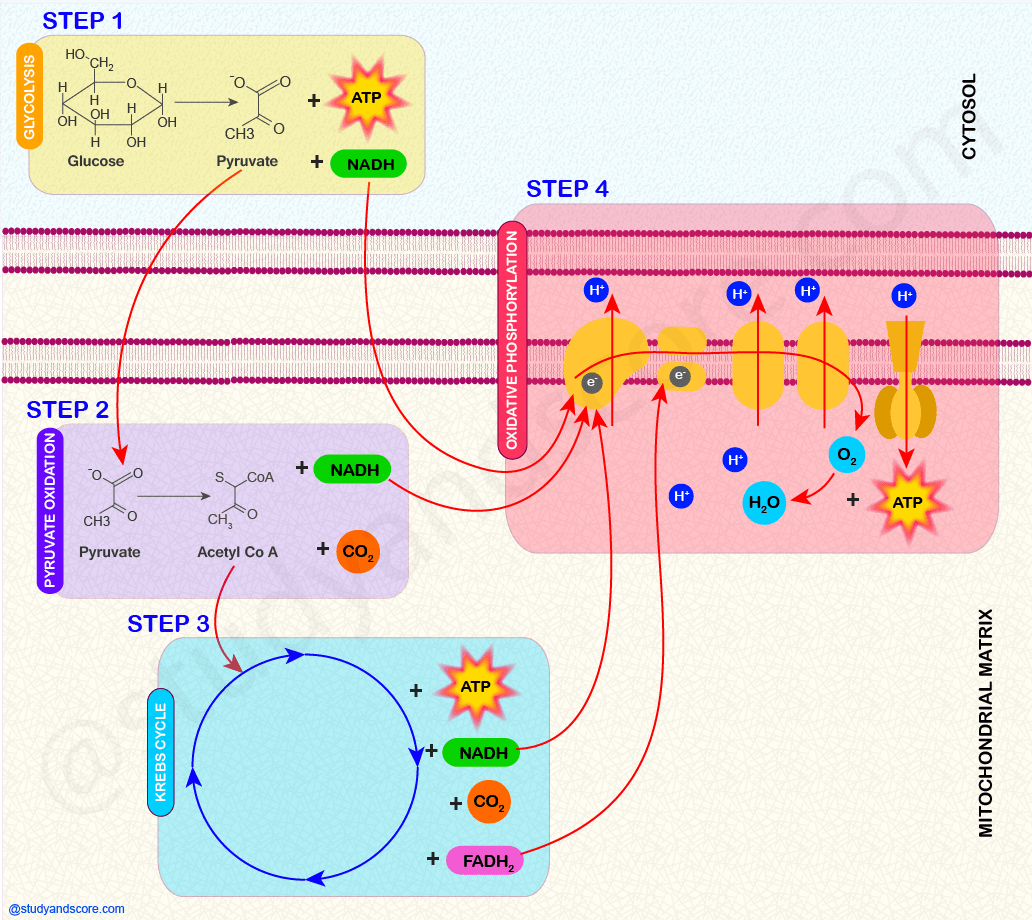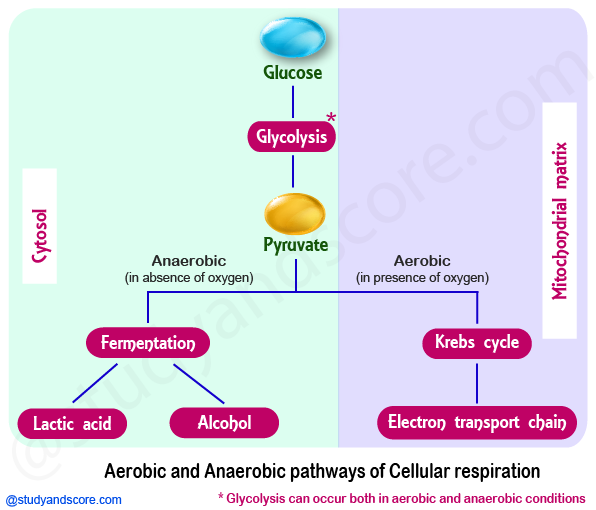All living organisms need continuous supply of energy to carry out functions and be alive. Some functions like metabolism of food, synthesis and transport of ions and molecules etc., occur continuously whereas other functions like contraction of muscles etc., occur only sometimes.
Cell respiration is a complicate process by which living organisms get energy from the food to carry out various biological functions. Animals get their energy by oxidation of food while plants get their energy by trapping the sunlight with the help of chlorophyll. Before plants and animals can use this energy, it is converted into a usable form through the process called cell respiration.
When cellular respiration occurs in the presence of oxygen it is called aerobic respiration and when it occurs in the absence of oxygen it is called anaerobic respiration. The cells of Prokaryotes perform cellular respiration in the cell cytoplasm. The cells of eukaryotes perform cell respiration both in the cytoplasm and mitochondria.
There are four stages in cellular respiration namely glycolysis, pyruvate oxidation, Krebs cycle and oxidative phosphorylation. Out of these stages only glycolysis can take place both in the presence and absence of oxygen. The remaining three stages require the presence of oxygen.
Aerobic respiration: Aerobic respiration occurs in the presence of oxygen. At the end of all the stages of cellular respiration, if enough oxygen is present then about 38 ATP can be produced as the end product of glycolysis is forwarded to Krebs cycle. Aerobic respiration is distinguishing feature of eukaryotic cells when oxygen is abundant.
Anaerobic respiration: Glycolysis can occur even in the absence of oxygen. It is the characteristic feature of anaerobic bacteria. Sometimes, eukaryotic cells also choose anaerobic respiration when the supply of oxygen is low. In anaerobic respiration, the end product of glycolysis is forwarded to fermentation reaction to produce NAD+ and ethanol. Here only 2 ATP are produced. For example, if the muscle cells work too much, the oxygen supply becomes low and the cells have to choose anaerobic path to get enough ATP. This produces lactic acid which is the main reason for the pain in muscles.
| Aerobic respiration | Anaerobic respiration |
|---|---|
| It occurs in the presence of oxygen | It occurs in the absence of oxygen. |
| All the stages of cellular respiration occur in Aerobic state. | Only glycolysis can occur in anaerobic state. |
| It is distinguishing feature of eukaryotic cells when oxygen is abundant. | It is the characteristic feature of anaerobic bacteria. But eukaryotic cells also choose anaerobic respiration when the supply of oxygen is low. |
| Here, the end products of glycolysis proceed towards Krebs cycle. | Here, the end products of glycolysis proceed to fermentation. |
| About 38 ATP are produced at the end of cellular respiration. | Only 3 ATP are produced at the end of cellular respiration. |
The starting material for cellular respiration is glucose. Glucose is the chief form of carbohydrate found in blood and other body fluids. When carbohydrates like starch, sucrose and lactose present in the food are digested, they give out monosaccharides like glucose, fructose and galactose. These monosaccharides then slowly move in to the blood stream. Glucose has energy stored in its chemical bonds. Cellular respiration converts this chemical energy into (ATP) energy which can be used by the cells.
Carbohydrates are chief source of energy
Of all the biomolecules, carbohydrates supply more than half of the energy required by the body. It is important to note that human brain ceases to function properly, when the level of the blood glucose falls below the normal range. Generally all the monosaccharides are completely absorbed by the small intestine whereas the glucose circulating in the blood is taken up by the body cells and used up for energy production.
Carbohydrate is the chief source of energy and it provides energy required for other metabolic processes. The metabolic intermediates of carbohydrate metabolism are used for various other biosynthetic reactions. Cells mainly use carbohydrate in the form of glucose. Major part of the glucose obtained from the diet is converted into glycogen and is stored in liver. Glucose is broken down in the cells through Glycolysis and Tricarboxylic acid cycle.
The following is the overall reaction of cellular respiration. Though this reaction appears to a reverse reaction of photosynthesis, the internal steps involved are different.
|
Overall cellular respiration C6H12O6+6O2 → 6CO2+6H2O+ ~38 ATP |
|---|
We can observe from the above equation that, during cellular respiration one glucose molecule is gradually broken down into carbon dioxide, water and 38 ATPs. In this process, an initial investment of ATP is required but at the end of the cellular respiration, much more ATP is yielded. Cellular respiration occurs partially in cytoplasm and partially in the mitochondria. The following are the four phases of cellular respiration,

1. Glycolysis: Glycolysis is the splitting of glucose molecule. It takes places in the cytoplasm of the cell. In glycolysis, 1 molecule of glucose (six-carbon sugar) is broken down to yield 2 molecules of pyruvic acid (three-carbon organic molecule). The end result of glycolysis is the production of 2 ATPs, 2 protons, 2 NADH and 2 pyruvic acid molecules per 1 glucose molecule.
|
C6H12O6 + 2NAD+ + 2ADP + 2P ↓ 2(CH3(C=O) COOH + 2ATP + 2NADH + 2H+ |
|---|
2. Pyruvate oxidation: Cellular respiration further takes place in the inner mitochondrial compartment. Pyruvic Acid the end product of glycolysis is shuttled into the mitochondria and here it is converted into acetyl CoA (a two-carbon molecule bound to Coenzyme A). The end result of pyruvate oxidation is the production of Acetyl CoA, Carbon dioxide and NADH.
|
(CH3(C=O) COOH + NAD+ + CoA-SH ↓ (CH3(C=O)-S-CoA) + CO2 + NADH |
|---|
What if our body does not have any glucose?
If our body does not have any glucose, then there would be no glycolysis. Then body gets the energy from the alternate sources like fats and proteins.
Fatty acids: Fatty acids are stored as triacylglycerol in the cells of adipose tissue present just beneath the skin. When our body does not have any glucose, lipases are released into the bloodstream and these lipases break down fats in the bloodstream or they move to adipose tissue to breakdown triacylglycerol.
Lipases remove glycerol heads from fatty acids and glycerol is converted to Phospho glyceraldehyde (an intermediate in glycolysis) which later enters cellular respiration in the cytoplasm. The fatty acid tails are converted to Acetyl CoA which enters Krebs cycle in the mitochondria.
Still, here the result of cellular respiration is production of 32-38 ATPs from Fatty acids and not glucose.
Proteins: When we consume proteins, the extra protein cannot be stored like fatty acids rather it has to be broken down. Proteases break the proteins in to amino acids. Then deaminases remove the amino group from the amino acids and release ammonia. This toxic ammonia is converted to urea and is excreted in urine.
The remaining constituents of amino acid namely carbon, hydrogen, and oxygen are rearranged to enter cellular respiration either as pyruvate or acetyl CoA.
Still, here the result of cellular respiration is production of 32-38 ATPs from proteins and not glucose.

3. The Krebs cycle: It is also known as Citric Acid Cycle. It takes place in the mitochondrial matrix. The acetyl CoA formed in pyruvate oxidation combines with oxaloacetate (a four-carbon molecule) and goes through a cycle of reactions, finally regenerating oxaloacetate molecule. The end result of Krebs cycle is production of Co enzyme-A, carbon dioxide, ATP, NADH+ and FADH+
|
(CH3(C=O)-S-CoA) + 3 NAD + FAD + ADP + HPO4-2 ↓ 2 CO2 + CoA + 3 NADH+ + FADH+ + ATP |
|---|
4. Oxidative phosphorylation: It takes place in the cristae of the mitochondria and the folded membranes inside the chloroplast (in plants). The NADH and FADH formed in previous steps give their electrons in the electron transport chain. Now they turn back to NAD+ and FAD respectively.
The electrons from NADH and FADH move down the chain to release energy. This energy is used to pump protons out of the matrix and it creates concentration gradient. The difference in the gradient drags the protons back into the matrix with the help of ATP synthase enzyme. This process is known as chemiosmosis. At the end of the electron transport chain, oxygen accepts electrons and takes up protons to form water molecules.
A detailed explanation of each of these steps is given in next few articles...
Hope you have liked this post.
Please share it with your friends through below links.
All the very best from Team Studyandscore
“Study well, Score more…”
- Share with your friends! -
Login to post your comment here...
- or with social Account -